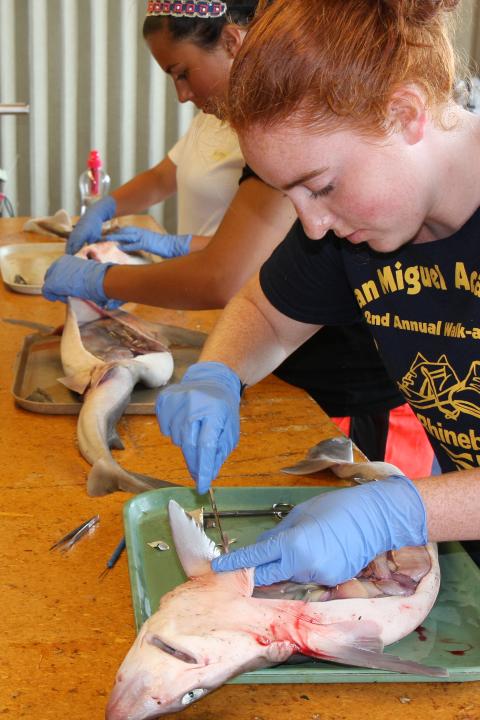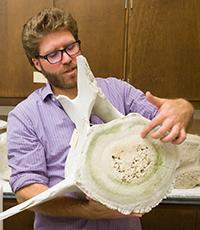Course Dates
June 16, 2025 to June 30, 2025
Prerequisites
One semester of college-level biology or equivalent.
Equivalent Note
Cornell students: Biology & Society majors, this course fulfills the (II) Foundation Courses > (C) Biology Foundation > Biological Diversity requirement.
Course Description

In this course, students will study structure, evolution, physiology, and biomechanics to investigate how vertebrates use anatomy to interface with the marine environment. Activities include marine mammal necropsies, trawling, whale watching, trips to the intertidal, and visits to nearby seal and seabird colonies. Each student will complete an independent research project on a topic within the field of anatomy and function.
Learning outcomes for this course include:
- Identify structural adaptations of marine vertebrates from the various anatomical systems;
- Demonstrate good dissection technique;
- Understand mechanisms of animal movement by integration of structural mechanics, muscle physiology, kinematics and fluid mechanics;
- Examine evolutionary pathways and selective pressures for the development of anatomical systems to function in the marine environment.
Internship opportunity: This course is a recommended experience for SML's Marine Mammal Internship.
"This two-week course prepared me more for med school than any other college class I took!" - Maya Koretzky (AFMV '11, AFMV TA '12)
Status
Closed
Course Numbers
Cornell: BIOSM 3210 (3 Credits)
UNH: MEFB 754 (4 Credits)
Faculty
Dr. Nicholas Gidmark

Dr. Nick Gidmark is an Assistant Professor at Knox College. He is an equal opportunity zoologist, but he typically studies musculo-skeletal biomechanics, focusing on food capture and processing (i.e. teeth, jaws, and their associated muscles). His research has taken him throughout the vertebrates, from sharks to salmons to shiners to swine. His least favorite surgical subject is the turkey, though that may be his favorite culinary subject. Nick's current research program focuses on: I) the biomechanics of chewing & swallowing in monkeys; II) anatomy and muscle physiology in the jaws of sunfishes; and III) the biomechanical importance of mandibular fusion in rats. Nick has conducted NIH- and NSF-funded postdoctoral research fellowships at Brown University, Friday Harbor Marine Laboratories (University of Washington), and the University of Chicago. He finished his PhD in comparative anatomy and biomechanics at Brown University in 2012. His undergraduate degree from the University of Minnesota was in fisheries management and conservation biology. He has spent most summers in the last 15 years at Shoals teaching two courses (This course and one on shark biology) and taught Biology of Fishes at Friday Harbor Marine Laboratories (University of Washington) while in residence there. At Knox, he teaches introductory biology, research methods, Comparative Vertebrate Anatomy, Biology of Fishes, and Animal Physiology. Collaboration with undergraduates in research is the single most rewarding highlight of Nick's career (and why he now is faculty at a small liberal arts college instead of a university), and these endeavors have led to dozens of conference presentations and several peer-reviewed publications.
Emily McParland

PhD student, Department of Ecology, Evolution and Organismal Biology, Brown University
Emily McParland is a PhD student at Brown University in the Department of Ecology, Evolution, and Organismal Biology. Much of her research interests lie in marveling at the amazing structures that animals have evolved and how they perform in their specific environments. She completed her Bachelor's of Science at Knox College where she studied mammalian jaw joint form and function. During her time at Knox, she quantified jaw joint motions during rat chewing and evaluated precision and utility of a comparative biomechanics tool in studying jaw joint disorders. Post-grad she worked as a post-baccalaureate research assistant at the University of North Carolina at Chapel Hill where she studied how cell-cell adhesive junctions connect to the actomyosin cytoskeleton, allowing cells to change shape and move during fruit fly development. Her graduate work focuses on the form and function of skeletal muscle in vertebrates with special emphasis on intramuscular connective tissue function and whole muscle design in musculoskeletal systems that operate without the speed- and displacement-amplifying benefits of skeletal levers. She also plans to leverage marine vertebrate anatomical diversity to learn more about the evolution of extraocular muscles (the muscles that direct eye gaze) in vertebrates. Emily first took AFMV in 2019 where she studied variation in shark and skate skin structure across species and has returned to SML to teach every summer since. The most rewarding part of teaching AFMV is seeing students who have never touched a scalpel before grow into asking their own questions about form and function. Her favorite anatomical endeavor was the articulation of a nine-foot horse skeleton. The worst smell she has ever experienced was either a mostly rotten seal or a fully rotten hog.
Check out this article (and video) about mummichog locomotion conducted by Dr. Stacy Farina and Noah Bressman (SML '11, '13, Cornell '16). Noah began this project as a student in Anatomy & Function of Marine Vertebrates, and it turned into an undergraduate thesis and a published scientific paper.
Read: "Back-Flipping Fish Look Before They Leap Across Land"
